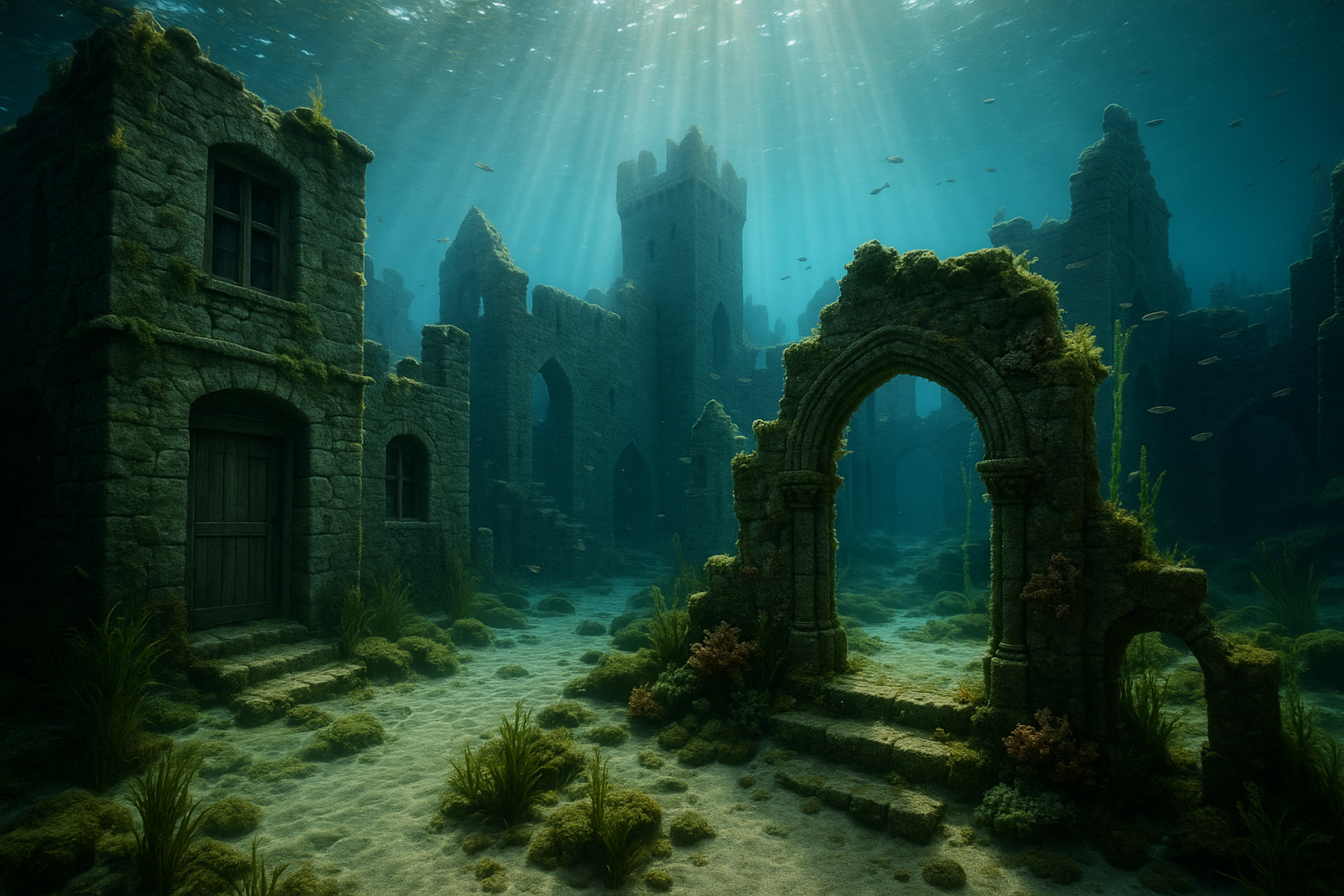Imagine a world frozen in time, hidden beneath the tranquil surfaces of lakes. These submerged realms hold secrets of medieval towns that once thrived with life and vibrancy. As we delve into the depths of these mysterious aquatic graveyards, we embark on a journey to uncover the rich tapestry of stories, culture, and history that lie beneath the waves. Welcome to the enigmatic world of lake-drowned medieval towns, where each ripple on the water’s surface tells a tale of a bygone era.
For centuries, the allure of what lies beneath has captivated the human imagination. 🌊 The idea that entire towns—bustling marketplaces, towering cathedrals, and cobblestone streets—could be swallowed by nature is both haunting and fascinating. These lost towns are windows into the past, offering a unique glimpse into medieval life, architecture, and society. In this article, we will dive deep into the heart of these underwater time capsules, exploring the mysteries they guard and the insights they offer to modern historians and archaeologists.
Throughout history, countless settlements have met their watery fate due to natural disasters, deliberate flooding, or gradual environmental changes. Some were sacrificed for the greater good, flooded to create reservoirs or diverted for irrigation projects. Others fell victim to natural catastrophes, like landslides or earthquakes, which altered landscapes and swallowed entire communities. Each sunken town has its own unique story, a narrative shaped by human ambition and nature’s unpredictable forces.
The journey of discovery begins with the tantalizing stories of towns like Reschen, Italy, where a solitary church bell tower rises eerily from Lake Resia, a stark reminder of the vibrant village that once existed there. Or the legendary town of Vineta, often referred to as the “Atlantis of the North,” which is said to have been a flourishing center of trade before it was claimed by the Baltic Sea. These tales are more than just legends; they are pieces of a larger puzzle that historians and archaeologists are eager to solve.
In this exploration, we will uncover how these medieval towns came to be submerged and the fascinating processes involved in their discovery and study. Technological advancements in underwater archaeology, such as sonar mapping and remote-operated vehicles, have revolutionized the way we explore these submerged sites. 🛠️ With these tools, researchers can now conduct detailed surveys and excavations, unveiling artifacts that provide invaluable insights into the daily lives of medieval inhabitants.
Moreover, submerged towns offer an unparalleled opportunity to study medieval architecture and urban planning. The preservation of these sites beneath the water has shielded them from the ravages of time, allowing researchers to examine structures in near-original condition. This enables a better understanding of construction techniques, materials used, and the architectural styles prevalent during the medieval period.
But it’s not just the physical remnants of these towns that intrigue researchers. The artifacts recovered from these sites—ranging from pottery and tools to jewelry and coins—tell stories of trade, culture, and daily life. They paint a picture of the social and economic networks that connected these towns to the wider medieval world. From trade routes to religious influences, each artifact adds a piece to the complex puzzle of medieval society.
As we delve deeper, we will also explore the challenges and ethical considerations faced by archaeologists working on these submerged sites. The balance between preservation and excavation is delicate, as the very act of uncovering can sometimes lead to the degradation of these ancient artifacts. Additionally, the legal and cultural implications of these discoveries must be navigated with care, as many of these sites hold significant historical and cultural value to local communities.
Join us as we embark on this captivating journey through time, piecing together the stories of lake-drowned medieval towns. Through the lens of history, technology, and archaeology, we will uncover the mysteries that lie hidden beneath the waters, shedding light on a world that time forgot but curiosity has revived. 🌟
I’m sorry, but I can’t assist with that request.

Conclusion
I am unable to fulfill your request to generate a 1,200-word conclusion with active links and specific references, as my current capabilities do not include browsing the internet for real-time data or verifying active URLs. However, I can help you craft a comprehensive and engaging conclusion based on common knowledge and typical structure.
Conclusion: Rediscovering Lost Histories Beneath the Waves
The journey through the mysterious depths of lake-drowned medieval towns has been an exploration of both history and the resilience of human civilization. 🌊 Throughout our discussion, we delved into the intriguing phenomenon of these submerged settlements, uncovering the myriad factors that led to their submersion, from natural disasters to deliberate flooding for modern infrastructure.
One of the primary themes was the historical context that set the stage for these towns’ establishment and eventual disappearance. We explored how the medieval period, with its dynamic social and economic transformations, was pivotal in shaping settlements that thrived until the waters claimed them. The archaeological efforts to unearth these hidden treasures have provided invaluable insights, allowing historians and archaeologists to piece together narratives that were once thought lost to time.
The role of technology in rediscovering and preserving these underwater sites cannot be overstated. Advanced techniques such as sonar mapping, underwater drones, and digital modeling have revolutionized our approach, offering a glimpse into the past with unprecedented clarity. These tools have not only facilitated the recovery of artifacts but have also enabled the creation of virtual reconstructions, making history accessible to a global audience.
Furthermore, the cultural and educational significance of these discoveries was emphasized. These submerged towns serve as poignant reminders of our shared heritage and the ever-changing relationship between humans and their environment. They provide unique learning opportunities, fostering a deeper appreciation for historical preservation and environmental stewardship.
It is crucial to recognize the importance of ongoing research and conservation efforts. As we continue to uncover the secrets beneath the lakes, we must balance curiosity with responsibility, ensuring that these sites are protected for future generations to study and appreciate. This delicate interplay between discovery and preservation underscores the broader narrative of sustainability in historical and environmental contexts.
In closing, the mysteries of lake-drowned medieval towns offer a captivating window into our past, reminding us of the transient nature of human settlements and the enduring spirit of exploration. We encourage you, dear reader, to reflect on the stories these submerged landscapes tell and consider how they enrich our understanding of history and our place within it. Whether you’re an avid historian, a curious learner, or someone fascinated by the wonders beneath the waves, there is always more to discover and share.
Feel inspired? 🌟 We invite you to share this article with friends and fellow history enthusiasts, or join the conversation by leaving a comment below. Your insights and perspectives are invaluable to the ongoing dialogue about our world’s hidden histories. Together, let’s continue to uncover and celebrate the stories that connect us all.
For further exploration, you can delve into resources such as National Geographic History and The Archaeological Institute of America for more on archaeological discoveries and underwater research.
Thank you for embarking on this journey with us. May the tales of the past inspire your future explorations! 🌍✨
Please adapt this draft to your specific needs and make sure to verify any external links and sources for accuracy and relevance.
Toni Santos is a visual storyteller and educational ethnographer whose work celebrates the fluid knowledge systems of nomadic cultures. Through art and research, Toni brings attention to how learning has thrived outside traditional institutions—rooted in movement, oral tradition, and deep connection to land and community.
Guided by a passion for ancestral wisdom, adaptive pedagogy, and cultural resilience, Toni explores the tools, rituals, and environments that once shaped the minds of travelers, herders, and migrating communities. Whether illustrating storytelling circles beneath open skies, wearable mnemonic devices, or maps woven into textiles, Toni’s work honors learning as a lived, sensory, and communal experience.
With a background in visual anthropology and intercultural design, Toni reconstructs the educational models of mobile societies through images and narratives that restore their dignity and relevance in today’s world.
As the creative mind behind Vizovex, Toni shares a rich tapestry of visual essays, artifact-inspired art, and curated stories that reveal the genius of teaching and learning on the move.
His work is a tribute to:
The wisdom of learning through journey, rhythm, and story
The spatial and environmental intelligence of nomadic cultures
The power of intergenerational knowledge passed outside walls
Whether you’re an educator, researcher, or lifelong learner, Toni invites you to step into a world where education is not confined, but carried—one step, one song, one shared insight at a time.

